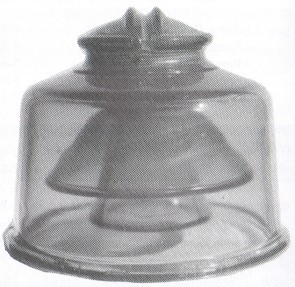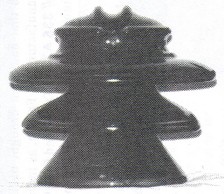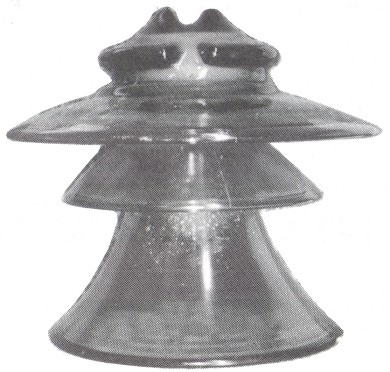Foreign Insulators
by Marilyn Albers
Reprinted from "Crown Jewels of the Wire", December 1996, page 24
NOT YOUR EVERYDAY INSULATORS
BEHEMOTH #1
Richard Selleh of Thompsons, Texas, wrote me several weeks ago to describe a
very large glass insulator in his collection. Judging from the measurements and
photos of the piece I was pretty sure it was going to need a new CD number, but
Woody would need to see this monster face to face before making a decision.
Mailing it to me was not an option, so Richard agreed to bring it to the NIA
Central Regional Show in Houston the weekend of September 7th and 8th.

CD 399.5
About midway through Saturday of the show, I looked up and there stood
Richard. He said “I have the insulator, shall I bring it in”? Minutes later,
this gargantuan hunk of green aqua glass was resting on my table and collectors
gathered around it like flies! They all thought it looked like a giant cake
saver and it does, actually. According to Webster’s dictionary, the word “Behemoth”
refers to any huge animal. This description certainly fits Richard’s
insulator.
It would take a few days to make a shadow profile and get good clear photos
of it, so Richard agreed to let us keep it for a few days. It is 10½" in
height, it has a base diameter of 12¾" and it weighs 37 lbs. The photo
shows that it has two inner skirts or bells. I won’t dwell on the difficulties
of handling, measuring, and photographing such a large insulator, but the next
day every muscle in my body reminded me of what I had been doing. A few days
later, husband Bill and I drove to Thompsons and handed the “big one” back
to Richard. N.R. Woodward has classified this beautiful insulator as CD
399.5.
The owner of the antique shop where Richard bought the insulator said that it
was one of two that had been brought back from Iran. However, it was actually
manufactured in France, as indicated by the crown embossing “EIV No
// 335 AT”.
CD 398 and CD 399, also EIV products, are smaller variations of this same style
and can be found in the book “GLASS INSULATORS FROM OUTSIDE NORTH AMERICA”,
but this much larger version is big news! All three sizes are referred to as “fog
bowls”, designed to be used in damp areas such as seaports. Many thanks for
loaning us your insulator, Richard. It is a welcome addition to the CD chart.
BEHEMOTH #2
Earlier this year Bernie Warren and his son Will of Anchorage, Alaska, made a
trip to France in search of insulators, and he came back with a wide variety of
beautiful glass and porcelain pieces. Bernie’s favorite one was a huge glass
four piece multipart in 7-Up green, with the crown embossing “FOLEMBRAY/
No 4390”. The height of the insulator is 15", the base diameter is 13",
and it weighs a back breaking 53 lbs! Fortunately, he didn’t have to climb the
pole to bring it down! This insulator has been classified as CD 370.5. Notice in
the photo (on the following page) how it dwarfs the CD 378 sitting next to it.
Bernie had some qualms about getting the insulator back to Alaska undamaged.
He decided to build a special box for it with tons of packing, and then he kept
his fingers crossed. His efforts paid off and the piece survived the plane ride
and the baggage handling system without a scratch. It is now the center of his
collection and he grins every time he walks by it. I would too, wouldn’t you?
 |
 |
|
CD 378 (on the left) is
dwarfed by the
CD 370.5 "FOLEMBRAY / No 4390" sitting next
to it. |
BEHEMOTH #3
This monster insulator resides on a shelf at The Glass Museum in Dunkirk,
Indiana. It is the only insulator there, though the Museum houses 5,000 pieces
of glass from 115 factories around the world. Mike Harris (Poneto, IN), Roger
Lucas (Columbus, IN), and Bob Stahr (Saint John, IN) have all been there to see
it, but last September Mike got permission from Mr. Webster, the museum’s
curator, to photograph and measure the insulator. “The story is that Hemingray
brought this insulator from France in order to run tests for a high voltage
project they had started, but the need for large glass insulators ceased before
the project went to production. Mr. Webster didn’t say how the piece got from
Muncie to Dunkirk, a distance of 20 miles.”
Upon close examination of the insulator, Mike discovered that what he first
thought was a three part insulator was actually a four piece. The innermost
skirt (or sleeve?) had been broken off at the pin hole, leaving quite a jagged
edge but no clues as to its configuration. He wrote me a letter with the all
information he had - photo, sketches, pencil rubbings, measurements, etc. Notice
in his photo that the insulators profile is similar to Bernie Warren’s CD
370.5, yet the crown is different. Unfortunately, since one part of it is
missing, this piece will not get a CD number until we can find a specimen that
is complete, or at least a catalog drawing of the insulator to determine the
structure of the missing part.
The insulator is crown embossed “FOLEMBRAY/No 5212”. Like the CD 370.5,
the glass color is 7-up green. It is 15" tall and has a base diameter of 10¾".
In spite of the missing inner skirt it weighs 36 lbs. One can only guess what
the insulator would weigh if it were complete! Thanks, Mike, for sharing the
story of this insulator.

Power Insulator Embossed "FOLEMBRAY / No 5212"
THREE LITTLE TEAPOTS ALL IN A ROW . . .

The first “teapot” on the left belongs to Lu Farin of Decatur, Texas. It
bears the trademark of Vereinigte Koppelsdorfer Porzellanfabriken or United
Porcelain Works of Koppelsdorf in (the state of) Thuringen, Germany. This unique
insulator appeared on page 42 of Gerald Brown’s Supplement to Collectible
Porcelain Insulators, Second Edition published in 1974. On the top of the
insulator he described what appeared to be “an imprinted square with illegible
letters or figures”. We don’t know if Lu’s insulator is the exact same one
as found in Brown’s book or if hers is a separate example. My eyesight is not
the greatest but I had no trouble making out this particular trademark, so her
insulator could very well be a duplicate. However, the style itself is really
quite rare.

The two teapots with spouts and no handles are unmarked, but it’s likely
they were also products of KVP. Before Mike Ford left Germany he managed to find
two with cable tops (only one shown here) and a third one with a round dome. All
three examples are of white porcelain with a chocolate brown glaze. They are
approximately 4" tall, give or take a couple whiskers. I have questioned
several porcelain collectors on the possible use of the spouts and/or handles on
these things but no one has come up with a definite answer because the style is
so rarely seen. Anyone out there have any comments? Have you seen these in any
of the foreign catalogs? All replies will be printed in the February issue of
Crown Jewels of the Wire.

Here we have a very interesting insulator with two side knobs for leading
down vertical lines. A truly unique style from England! It has a pretty cream
colored glaze and was made by Bullers of London, as indicated by the trademark
on the skirt. It measures 4" in height and has an arm span of 4½".
The proud owner is Mark Hilton of Buena Park, California, who was kind enough to
let me borrow the insulator to make a shadow profile and get measurements. No
U-number has been assigned at this time but I wanted to share this unique
insulator with Crown Jewels of the Wire readers. Thanks for letting me borrow
it, Mark
.

AN
EXTRA-TERRESTRIAL
CREATURE?
Gotcha! You did wonder there for a minute, didn’t you? I just couldn’t
resist adding the “eyes” when I received this insulator from Mike Ford
during the last weeks of his military assignment in Germany. It is the spook of
all spooks and certainly took its place among the goblins by our front door on
Halloween.
I don’t know exactly how the insulator was used - whether the holes were
meant to hold tie wires or metal bolts, or ????? Does anyone out there in
readerdom have a clue? This oddball creature is made of very heavy brown plastic
and in the pin hole is a metal thimble with tiny metric threads. Up inside the
skirt is the marking: “WEMA GS 1-2” followed by the production date ‘A
84", or April of 1984. My friend (and yours) Marco Schmitz-LeHanne of
Krefeld, Germany recognized the name “WEMA” and was able to give me some
information about the manufacturer.
The Driescher Corporation, located in the German state of Bavaria,
manufactures all sorts of equipment for electrical distribution such as
insulating materials, switches, fuses, cables, etc. It is owned and operated by
two brothers, Werner and Manfred Driescher. WEMA, one of the subsidiaries
belonging to the corporation, produces special plastic parts, including this
insulator, to be used along with the various types of electrical equipment. The
name WEMA is derived from the first two letters of each brother’s Christian
name - WE for Werner and MA for Manfred. I sure appreciate your help, Marco. If
you ever see one of these insulators in service, would you please try to get a
good clear photo of it so it can shared with CJ readers?
|
